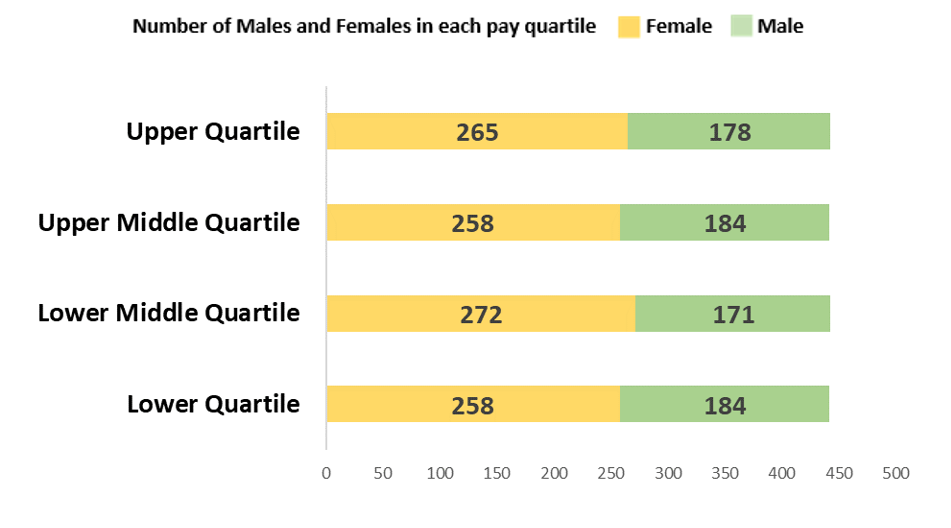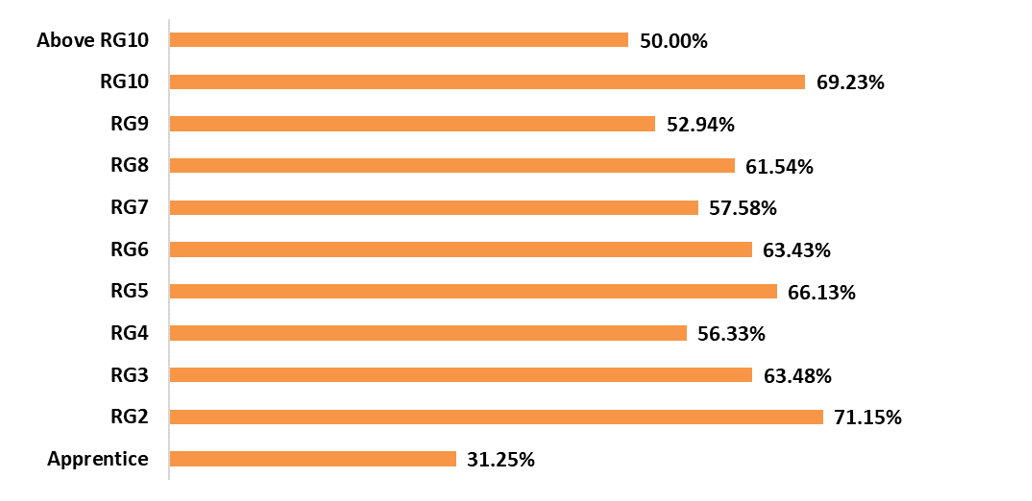Gender Pay Gap Report for 2024
1. Purpose of the report
1.1 From April 2017, under the Equality Act 2010 (Specific Duties and Public Authorities) Regulations 2017, employers with 250 or more employees are required to publish statutory gender pay gap calculations every year.
1.2 To make the calculations, data must be extracted from the Council’s payroll on a specific date each year. This specific date is called the ‘snapshot date’, which is 31 March for public sector organisations.
1.3 The calculations must be published on the Council’s website and the Government Equalities Office website by 30 March 2024. This report sets out the figures that will need to be published and an analysis of the information.
2. Introduction and background
2.1 The information that is required for publication is:
| Mean gender pay gap | The difference between the mean hourly rate of pay of male full-pay relevant employees (FPREs) and that of female full-pay relevant employees. |
| Median gender pay gap | The difference between the median hourly rate of pay of male full-pay relevant employees and that of female full-pay relevant employees. |
| Mean bonus gap | The difference between the mean bonus pay paid to male relevant employees and that paid to female relevant employees. |
| Median gender pay gap | The difference between the median bonus pay paid to male relevant employees and that paid to female relevant employees. |
| Bonus proportions | The proportions of male and female relevant employees who were paid bonus pay during the relevant period. |
| Quartile pay bands | The proportions of male and female full-pay relevant employees in the lower, lower middle, upper middle and upper quartile pay bands. |
2.2 For the purpose of this report, the workforce profile as at the ‘snapshot date’ date of 31 March 2024 was 1770 full-pay relevant employees (FPREs), which is made up by 1053 (59.5%) women and 717 (40.5%) men. The Council’s data excludes the children’s services workforce which transferred to Brighter Futures for Children (BFfC) on 1 December 2018. BFfC are now required to report their gender pay gap separately.
2.3 In accordance with Government’s guidance, data for school staff is not included in this report. The figures in this report have been calculated in accordance with the Government’s guidance by the HR Systems Team in HR and Organisational Development. The highlighted figures in each table are those that will require publication.
Table 1 – mean and median gender pay gap
| Men | Women | Women’s earnings are: | |
| Mean Hourly Rate | £19.49 | £19.19 | 1.57% lower |
| Median Hourly Rate | £17.59 | £17.59 | 0% |
Table 2 – mean and median gender pay gap in bonus payments
| Men | Women | Women’s bonuses are: | |
| Mean amount of bonus | £944.44 | £946.67 | 0.24% higher |
| Median amount of bonus | £1,000 | £1,000 | 0% |
Table 3 – Proportion of men and women who received a bonus
| Men | Women | |
| FPREs Total | 717 | 1,053 |
| Proportion of all those receiving a bonus | 9 (1.26%) | 15 (1.42%) |
3. Analysis
3.1 The annual survey of hours and earnings (ASHE) gender pay gap tables released by the ONS in 2023 reported that the median gender pay gap for Public Sector employees was 13.8%. Table 1 shows that the Council’s mean (1.57%) and median (0.00%) gender pay gap compares favourably with the national gender pay
gap figure.
3.2 Tables 2 and 3 reflect a small group of employees who received “bonuses” in the relevant period. The Council does not have provision for the payment of bonuses within its terms and conditions. However, long service awards in the form of money meet the government’s definition of “bonus” for this report.
3.3 Long service awards at the Council are in recognition of achieving 20 years’ continuous service. The Council is currently running a long service scheme with varying cash values:
- A one-off money award of £1,000 for those achieving long service with the Council with the provision for employees to “trade in” all or part of the award for additional days’ leave, currently at the rate of £100 per day.
3.4 8 of the 9 men received the same cash value as 13 of the 15 women. This has, as a result, translated into a 0.24% pay gap, as shown in Table 2.
3.5 Based on how the gender pay gap is calculated, although the median gap is 0, it still exists as the mean gap 1.57% lower for women within the Council. There are more women than men at every pay quartile, yet 61% of staff in the lower middle and 60% of staff in the upper pay quartiles are women (see Figures 1 and 2 below).
3.6 Figure 3 illustrates the breakdown of men and women in each pay band. Pay band RG2 has the greatest proportion of women (71.5%), which is higher than the overall proportion
of women employed at the Council (59.5%). Job roles that fall into this pay band are primarily Cleaning Operatives. 65% of the women in this pay band are part-time.
3.7 The Council has a good balance of men and women at senior management level. Of the employees paid on Reading Senior Managers grades, i.e. earnings above £60,973 per annum, 50% are women.
Figure 1: Proportion of men and women in each pay quartile

Figure 2 – Number of men and women in each pay quartile on 31 March 2024

Figure 3: Proportion of women in each pay band on 31 March 2024

4. Conclusions
4.1 The small gender pay gap at the Council, which is much lower than the national average, is the result of the long-term effort that the Council has invested to ensure fair pay for all staff, including:
- Promoting and supporting a number of flexible working policies for all employees within the Council, irrespective of gender, including job share, part time working and term time working. In some areas there is also flexibility to work from different locations.
- The Council has a consistent pay structure and formal job evaluation process to ensure that we have a clear way of paying employees equally for the same or equivalent work, regardless of gender.
- Formal authorisation process for any changes in pay, including accelerated increments, market supplements and pay at starting appointments.
- Extended the right to request flexible working to all staff in 2010, 4 years before the Government changed the law.
- Enhanced Shared Parental Pay to mirror contractual Maternity Pay.
- Became an accredited “Living Wage Employer” in 2014 paying the Living Wage set by the Living Wage Foundation as a minimum to all employees at the lower level of the pay structure
5. Action plan/recommendations
5.1 Continue to promote the benefits of flexible working practices to employees and managers. In addition, the Council will monitor the take-up of flexible working arrangements by gender and level within the organisation.
5.2 Promote the benefits of working for the Council both internally and externally, such as apprenticeship opportunities, flexible working arrangements, diversity commitments etc.
5.3 Continue to require recruiting managers to attend the Council’s recruitment and selection training which highlights the issue of unconscious bias and inclusive recruitment during recruitment and interview processes.
5.4 Continue to ensure that recruiting managers use structured interviews as this is more effective at guarding against unconscious bias by ensuring that all candidates are asked the same questions and are assessed using pre-specified, standardised criteria.
5.5 Increase awareness about apprenticeship schemes to encourage more employees to improve their skills and experience giving them the opportunity to progress their career.